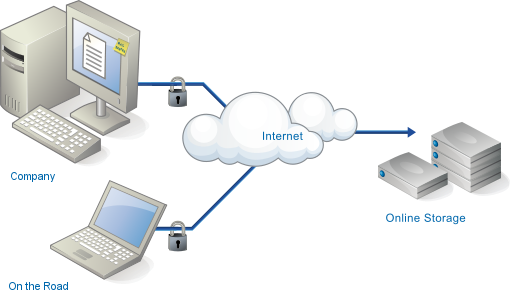Whether being part of a business or just as an individual, our need to access and store digital data has become an important aspect of our lives in this digital era. Most of the data which we collected under the form of paper has seen a shift to the digital format, changing the way we access and pass our information along to others. Whilst using our personal hard drives to store our data locally has been a method available for some time now, the increased predominance of the internet has given birth to a wider trend of online data storage. It is therefore worth looking at local vs online data storage to determine which one of those suits our needs best.
Local storage.
Local storage involves using our own hard drive, or system of hard drives to store our data. Those hard drives will be present where we are located; either at work or at home.The most basic method of storing our data locally is just to save it onto our computer’s hard drive. This has the advantage of being simple to do and makes it so that our data is easy to access from our personal or work computers. However it is a risky method, being the equivalent to storing all our eggs into the same basket. Dropping the basket will most likely break most of our eggs, which can be translated as breaking our hard drive leading to the loss of our precious data.
Another way to store files locally is to use a spare external hard drive and updating it regularly with our most recent data. If we also keep copies of our data onto our computer’s hard drive, this external device will serve as a spare backup of our data. That way if one of our drives fails, we still have the other one to fold back to. However, there are risks associated with doing this. If someone steals our spare drive, or even if we forget it somewhere; other people can use it to access our private info, potentially putting us at risk of data theft.
The other most common method of local file storage is to create our own RAID system. This will consist of using multiple drives in the same array, duplicating and spreading the data across those different drives. That way our data will still be accessible if one of the drives fail. It is worth noting that if this happens, the best way to recover our array is call upon RAID data recovery experts; as attempting those sort of repairs can lead to total data loss. RAID is a method favoured by businesses but should be considered by anyone whose electronic data is vital to their wellbeing.
Online Storage
Online storage methods have become more popular over the past few years by taking the form of cloud storage. Services such as Dropbox do a great job at integrating with your computer’s operating system; making it very easy to store and access you essential data.
Online access means that you can potentially access your data from any computer or even mobile device from all around the world; as long as you can find an internet connection. This offers a huge advantage over local data storage as you are not required to carry around any form of physical data storage with you.
Another great advantage of using online storage is that the data is spread around and backed up on servers to ensure that your data will still be available even if the server gets corrupted in the advent of hard drive failure. In essence, using online storage takes the specialist work away from you by making it as easy as possible.
The only real drawback of online storage is the cost, as storing a lot of data online can end up costing a fair bit as cloud storage companies often charge users depending on how much data they use. The cost issue won’t be apparent over a short term but will become more noticeable over time.
Making the right choice.
When it comes down to choosing which method is best suited to your needs, you should take into account a few factors: accessibility, convenience, security and cost. Balancing which ones of those are most important will help guiding you towards whether it is best to go for local or online data storage. But whichever method you choose, you will still have to make the effort to manage and keep on top of your data, as one of the greatest factor influencing the safety of our data remains human intervention.

 How SASE Solutions Empower Productive Workforces in a Digital Era
How SASE Solutions Empower Productive Workforces in a Digital Era  Excel vs PDF: Which Dominates Document Sharing in 2025? (Data-Driven Comparison)
Excel vs PDF: Which Dominates Document Sharing in 2025? (Data-Driven Comparison)  TitaniumInvest.com Money 2024: AI‑Driven Tools Outperform Traditional Banking
TitaniumInvest.com Money 2024: AI‑Driven Tools Outperform Traditional Banking  Why Your Link Building Efforts Might Fail
Why Your Link Building Efforts Might Fail  How to Request or Give Remote Control in a FaceTime Call on iPhone
How to Request or Give Remote Control in a FaceTime Call on iPhone  The Rise of Intelligent Automation in Business Operations
The Rise of Intelligent Automation in Business Operations  The Best Ideas for Designing Your Custom Printed Ring Binder
The Best Ideas for Designing Your Custom Printed Ring Binder  How Technology is Changing the Way We Play Hearts
How Technology is Changing the Way We Play Hearts  The Rise of Open Source: A Journey to Innovation and Collaboration
The Rise of Open Source: A Journey to Innovation and Collaboration 